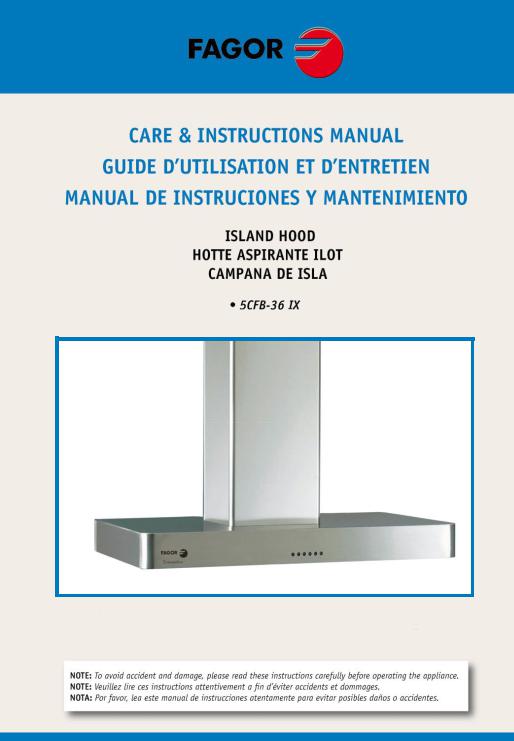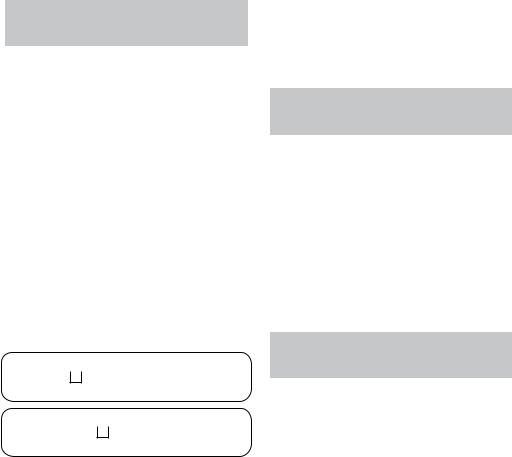FAGOR 5CFB-36 IX, ISLAND HOOD User Manual


GB |
The symbol |
on the product or on its packaging indicates that this product may not be treated as |
|
household waste. Instead it shall be handed over to the applicable collection point for the recycling of electrical and electronic equipment. By ensuring this product is disposed of correctly, you will help prevent potential negative consequences for the environment and human health, which could otherwise be caused by inappropriate waste handling of this product. For more detailed information about recycling of this product, please contact your local city office, your household waste disposal service or the shop where you purchased the product. This appliance is marked according to the European directive 2002/96/EC on waste electrical and electronic equipment (WEEE).
F Le symbole  sur le produit ou son emballage indique que ce produit ne peut être traité comme déchet ménager. Il doit plutôt être remis au point de ramassage concerné, se chargeant du recyclage du matériel électrique et électronique. En vous assurant que ce produit est éliminé correctement, vous favorisez la prévention des conséquences négatives pour l’environnement et la santé humaine qui, sinon, seraient le résultat d’un traitement inapproprié des déchets de ce produit. Pour obtenir plus de détails sur le recyclage de ce produit, veuillez prendre contact avec le bureau municipal de votre région, votre service d’élimination des déchets ménagers ou le magasin où vous avez acheté le produit. Cet appareil est commercialisé en accord avec la directive européenne 2002/96/CE sur les dèchets del équipments èlectriques et èlctroniques (WEEE).
sur le produit ou son emballage indique que ce produit ne peut être traité comme déchet ménager. Il doit plutôt être remis au point de ramassage concerné, se chargeant du recyclage du matériel électrique et électronique. En vous assurant que ce produit est éliminé correctement, vous favorisez la prévention des conséquences négatives pour l’environnement et la santé humaine qui, sinon, seraient le résultat d’un traitement inapproprié des déchets de ce produit. Pour obtenir plus de détails sur le recyclage de ce produit, veuillez prendre contact avec le bureau municipal de votre région, votre service d’élimination des déchets ménagers ou le magasin où vous avez acheté le produit. Cet appareil est commercialisé en accord avec la directive européenne 2002/96/CE sur les dèchets del équipments èlectriques et èlctroniques (WEEE).
E |
El símbolo |
en el producto o en su embalaje indica que este producto no se puede tratar como |
|
desperdicios normales del hogar. Este producto se debe entregar al punto de recolección de equipos eléctricos y electrónicos para reciclaje. Al asegurarse de que este producto se deseche correctamente, usted ayudará a evitar posibles consecuencias negativas para el ambiente y la salud pública, lo cual podría ocurrir si este producto no se manipula de forma adecuada. Para obtener información más detallada sobre el reciclaje de este producto, póngase en contacto con la administración de su ciudad, con su servicio de desechos del hogar o con la tienda donde compró el producto. Este electrodomestico està marcado conforme a la directiva Europea 2000/96/CE sobre los residuos de aparatos elèctricos y electrònicos (WEEE).
3

CONTENTS |
GB |
|
Warnings
Uses
Installation
Working
Maintenance
4

WARNINGS
*The appliance is not intended for use by young children or infirm persons without supervision. Young children should be supervised to ensure they do not play with the appliance.
*The cooktop surface and the inferior part of the range hood must be at a minimun distance of 65 cm.
When frying, please pay particular attention to fire risk due to oil grease. Since it is highly inflammable, fried oil is especially dangerous. Do not use uncovered electric grills. In order to avoid possible fire risk, all instructions for grease-filter cleaning and for removing eventual grease deposits should be strictly followed.
USES
*The air sucked can't be vented through or into a duct used to let out fumes from appliances fed by energy other than electric power (eg. centralized heating, radiators, water-heaters, etc.).
*To evacuate the air outlet, please comply with the pertaining rules given by authorities.
*Provide the room with an adequate aeration when a cooker hood and appliances fed by energy other than electric power (gas-, oil-, or coalstoves, etc.) are used simultaneously. The cooker hood, when evacuating the sucked air, could generate a negative pressure in the roomwhich can't exceed the limit of 0.04 mbar, in order to avoid the suck of exhausts deriving from the heat-source. Therefore the room should be provided with air-intakes to allow a costant flow of fresh air.
If the rating lable in the range hood shows the symbol  , the appliance is built in class II° and it does not need any earth connection.
, the appliance is built in class II° and it does not need any earth connection.
If the rating lable in the range hood does not show the symbol  , the appliance is built in class I° and it needs the earth connection.
, the appliance is built in class I° and it needs the earth connection.
The appliance is already arranged both for filtering and for suction performances.
*In its filtering version (Fig.1), the air and fumes vented by the appliance are depured both by a grease filter and by an active coal filter, and put again into circulation through the side-grids of the chimney. For this version an air deflector placed on the superior part of the pipe and allowing air-recycling is necessary (Fig.1).
*In its sucking version (Fig.2), fumes are directly conveyed outside, through an evacuation duct connected with the superior part of the wall or the ceiling. Both coal filter and air deflector are not necessary in this case.
INSTALLATION
* Before installing the appliance and in order not to damage the appliance itself, the metal grease filter should be removed. Such filter can be removed by pushing the special filter handle toward the back side of the ranger hood and turning it downwards so as to unfasten it from its slot (Fig. 3).
*When performing the electrical connections on the appliance, please make sure that the current-tap is provided with earth connection and that voltage values correspond to those indicated on the label placed inside the appliance itself.
*Before carrying out any cleaning or maintenange operations, the appliance needs to be removed from the electric grid.
If the appliance is not supplied with a non-separable flexible cable and plug, or with another device ensuring omnipolar disconnections from the grid, with an opening distance between the contacts of at least 3 mm, then such disconnecting devices must be supplied within the fixed installation.
If the appliance is supplied with a supply cord and a plug, the appliance has to be put in a place where the plug can be reached easily.
* The use of materials which can burst into flames should be avoided in close proximity of the appliance.
Attention: at least two people are needed to perform the installation.
Before fixing the hood, place the electric feeding properly into the ornamental pipe and place a hole for air evacuation in case of a sucking version.
* Suction model
Place the upper plate (Fig. 4.1) on the ceiling. Drill 4 holes, 8 mm each, just next to the slots.
Insert the plastic dowels into the holes (Fig. 4.1-A) and screw the plate on the ceiling (Fig. 4.1-B). Then fasten the lower structure (Fig. 6.2) on the hood by making its holes and the metric-thread screws welded on the fan support coincide (Fig. 6.1). Insert the washers and nuts provided (Fig. 6.2-A) and screw with an appropriate tool.
Connect the drainpipe to the power unit nozzle and fix securely with a hose clamp.
Insert the upper structure (Fig. 6.3) into the lowest one and adjust its height as required by matching it with the cooktop’s minimum height. Tighten the two structures 5 securely with the screws provided (Fig. 6.3-B).

Insert the two extension tubes (Fig. 6.4 & Fig. 6.5) from above the two structures by making them come down to the appropriate hood seat. Lift the hood together with the structure and the extension tubes to make the four springs (Fig. 6.6-E) hook to the slots (Fig. 6.3-C). Then tighten the two elements securely (Fig. 5.1 & Fig. 5.2) with the safety screws (Fig. 5.2-A) and connect the hood tube to the drain hole. Make the electrical connections. (For versions with display only) Lift the lower pipe until the cable strap coming out of the sucking unit is uncovered and connect it to the display cable strap. Put down the lower pipe while paying attention it is being properly introduced into the hood.
Lift the upper tube (Fig. 6.5) up to the ceiling and insert the two self-tapping screws (Fig. 6.5-D).
*Filtering model
Place the upper plate (Fig. 4.1) on the ceiling. Drill 4 holes, 8 mm each, just next to the slots. Insert the plastic dowels into the holes (Fig. 4.1-A). Fix the baffle (Fig. 4.2) to the upper bracket (Fig. 4.3) with the four self-tapping screws provided (Fig. 4.3A). Screw the plate together with the baffle (Fig. 4.1B). Then fasten the lower structure (Fig. 6.2) on the hood by making its holes and the metric-thread screws welded on the fan support coincide (Fig. 6.1). Insert the washers and nuts provided (Fig. 6.2-A) and screw with an appropriate tool. Connect the drainpipe to the power unit nozzle and fix securely with a hose clamp. Insert the upper structure (Fig. 6.3) into the lowest one and adjust its height as required by matching it with the cooktop’s minimum height. Tighten the two structures securely with the screws provided (Fig. 6.3-B). Insert the two extension tubes (Fig. 6.4 & Fig. 6.5) from above the two structures by making them come down to the appropriate hood seat. Lift the hood together with the structure and the extension tubes to make the four springs (Fig. 6.6-E) hook to the slots (Fig. 6.3-C). Then tighten the two elements securely (Fig. 5.1 & Fig. 5.2) with the safety screws (Fig. 5.2-A) and connect the hood tube to the baffle’s lower hole. Make the electrical connections. (For versions with display only) Lift the lower pipe until the cable strap coming out of the sucking unit is uncovered and connect it to the display cable strap. Put down the lower pipe while paying attention it is being properly introduced into the hood. Lift the upper tube (Fig. 6.5) up to the ceiling and insert the two self-tapping screws (Fig. 6.5-D).
Warning!
Before connecting the flexible exhausting pipe to the motor, make sure the stop valve, which is on the air outlet of the motor, can swing.
MAINTENANCE
*An accurate maintenance guarantees good functioning and long-lasting performance.
*Particular care is due to the grease filter panel. It can be removed by pushing its special handle toward the back-side of the range hood and turning the filter downwards so as to unfasten it from its slot (Fig. 8). To insert the filter just perform the opposite operation. After 30 hours of operation, the push button control panel will signal the saturation of the grease filter by lighting all the buttons. Press the timer button to reset
 . The grease filter should be cleaned by hand or in dishwasher at least every two months or depending on its use
. The grease filter should be cleaned by hand or in dishwasher at least every two months or depending on its use
* In case the appliance is used in its filtering version, the active coal filter (Fig. 8Z) needs to be periodically replaced. The coal filter can be removed by removing the grease filter first (Fig. 8B), and by pulling its special plastic tongue until it is unfastened from its slot. Reinsert the coal filter by reversing the steps. The coal filter needs replacing at least every six months depending on the use.
*To clean the appliance itself tepid water and neutral detergent are recommended, while abrasive products should be avoided. For Steel appliances specialized detergents are recommended (please follow the instructions indicated o the product itself to obtain the desired results).
*To replace the halogen lamps, remove first the glassblocking ring (Fig. 9A), by levering with a screw-driver and thus removing the opaque glass (Fig. 9B) - when performing this operation hold the opaque glass carefully. Remove the lamp (Fig. 9C) without touching it with uncovered hands. Replace it with another lamp of the same kind. After the replacement, re-insert the glassblocking ring and fasten it.
WORKING
Mod. 5CFB-36 IX luxury version (Fig. 7)
A: Light switch on/off
B: Motor switch on/off (1st rate level) C: 2nd rate level switch
D: 3rd rate level switch E: 4th rate level switch
6

INDEX |
F |
|
Attention
Version de l'appareil
Installation
Fonctionnement
Entretien
7
